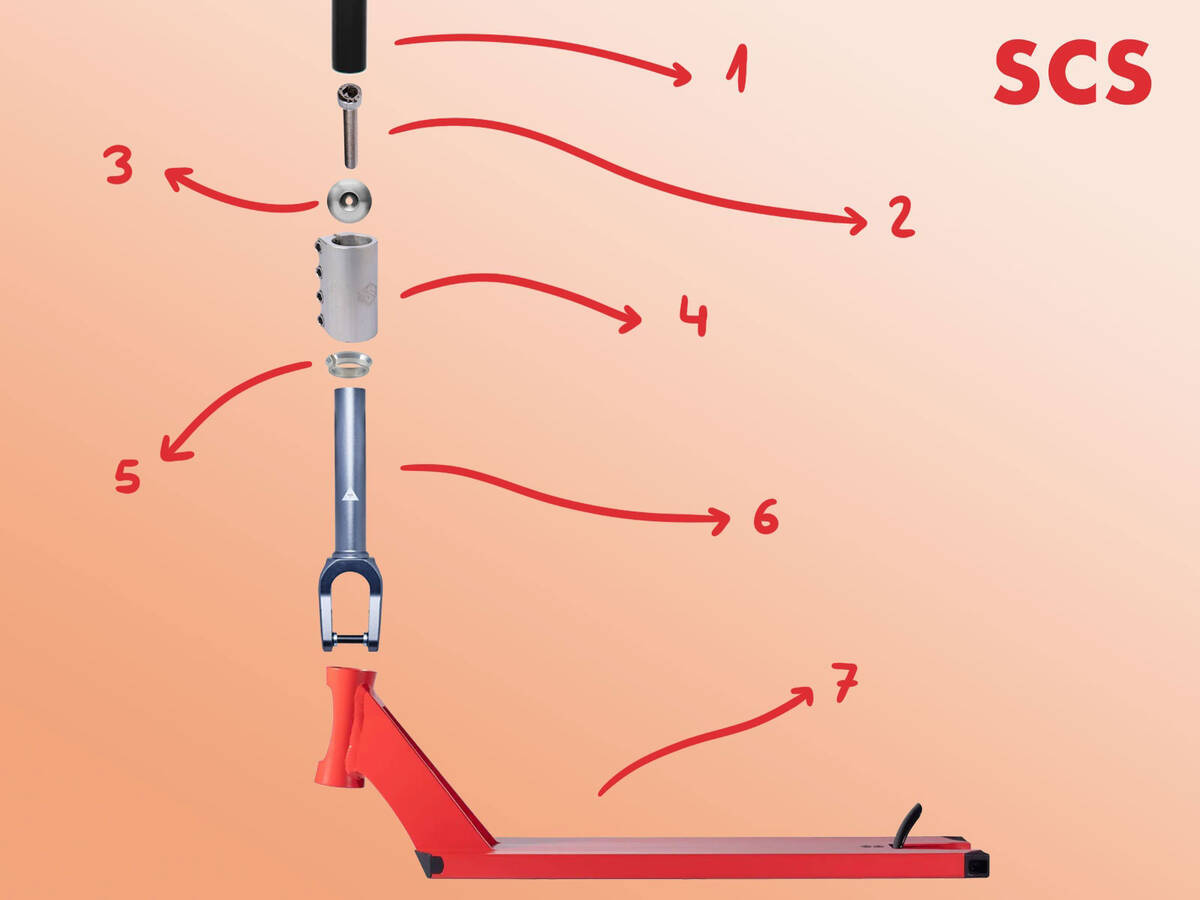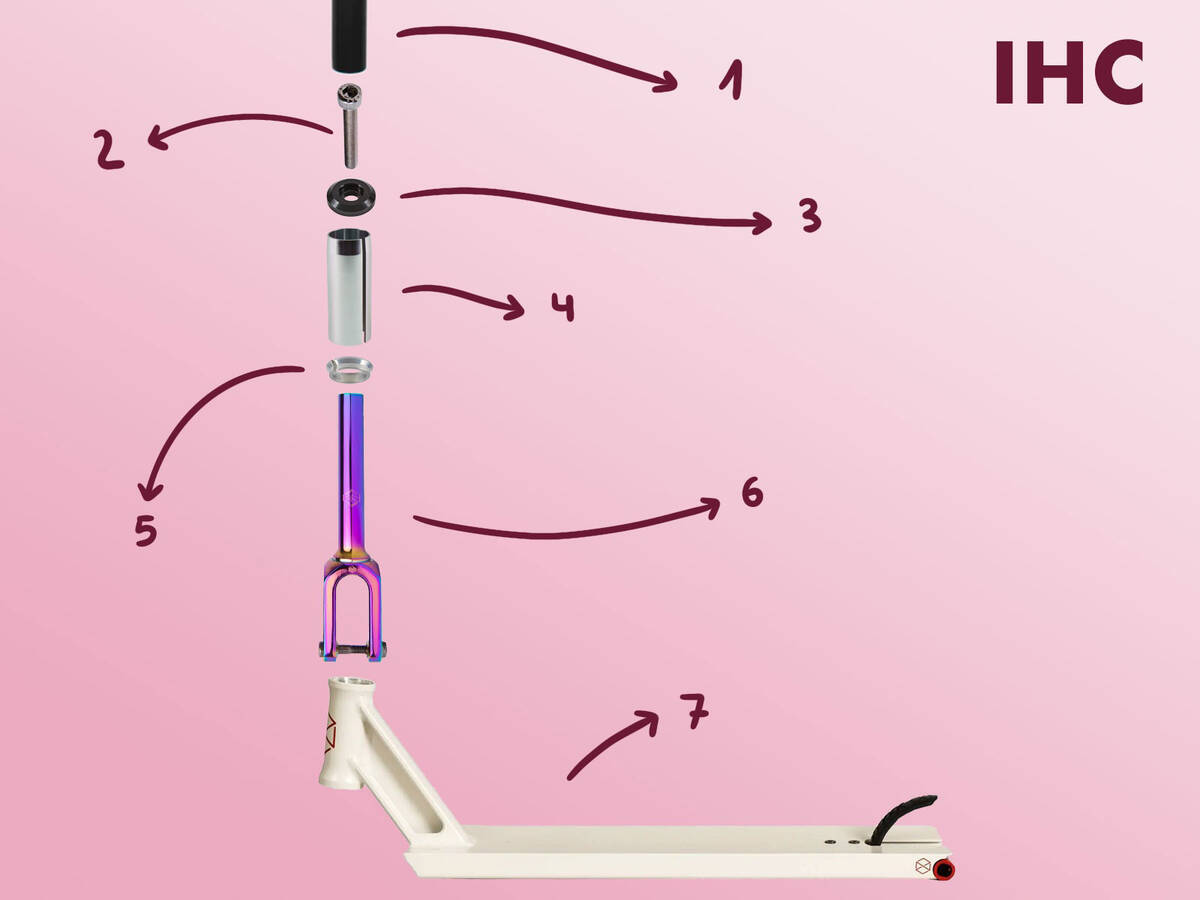Scooter Compression Overview

Pro scooter compression systems are crucial for your configuration. They ensure a firm connection between your bar, headset, and fork in the setup. Whether you're new to scootering or have some experience and are seeking a fresh compression kit, this guide offers vital insights into pro scooter compression.
We will discuss the advantages and disadvantages of the most prevalent compression systems and assess their compatibility with the other components of your scooter. By the conclusion, you'll understand which type of compression suits you best and how to maximize your pro scooter's performance.
SCS Compression Explained

1: Bar (no slit) 2: Compression Bolt 3: Top Cap 4: SCS Clamp 5: C-Ring 6: Fork 7: Deck (headtube & headset)
SCS, which stands for Standard Compression System, is favoured for its robustness and ease. It is considered the optimal compression system for intensive riding due to its strength. Although a bit heavier, SCS provides compatibility with both standard and oversized bars.
Installing SCS Compression
This system involves attaching the clamp to the fork with an internal compression bolt and a top cap that exerts pressure on an internal edge within the clamp. The bolt threads into a starnut or a built-in thread inside the fork, with newer SCS forks often featuring built-in threads. The clamp secures the bar using four bolts.
Watch the video below for a tutorial on SCS compression installation:
Bars that Fit SCS Compression
You'll need a bar without a bottom slit for an SCS setup. Otherwise, the clamp will squeeze the slit, potentially breaking the bar. You can either cut the bar to get rid of the slit or use a suitable SCS bar adapter.
SCS Clamps Specifics
An SCS clamp is necessary, as the compression mechanism is housed within the clamp. Ensure the inner diameter of your clamp matches the outer diameter of your bars—either the standard 32 mm or the oversized 35 mm size.
Note: If the inner edge of the SCS clamp is not higher than the fork top, achieving a sound connection with the fork will be impossible. Use a headset spacer to adjust the clamp's height.
SCS-Compatible Forks
Compatibility with SCS compression includes all HIC and SCS forks (HIC and SCS forks do not differ).
Understanding HIC Compression

1. Bar 2. Compression Bolt 3. Top Cap 4. IHC Shim 5. C-Ring 6. Fork 7. Deck (headtube & headset)
The term HIC refers to Hidden Internal Compression. Although not the lightest, it is lighter than SCS and simpler to put together. However, HIC needs a slit in the bar, which can weaken it—a downside not present in SCS.
Setting Up HIC Compression
To install HIC, an HIC shim is placed on the fork, and a compression bolt with a top cap secures it onto the scooter deck's headtube, fixing the fork in place. The bar is tightened around the fork tube using a clamp.
Watch the installation process of HIC compression parts in the following video:
HIC Bars
Bars compatible with HIC feature an internal diameter of 32 mm and an outer diameter of 35 mm, with materials such as steel or titanium for sturdiness. Aluminum bars have larger outer diameters but smaller interiors due to the thicker tubing required for durability. Thus, they are not suitable for an HIC setup. These bars include a slit at the base.
Choosing HIC Clamps
Your clamp should fully cover the bar’s slit for an HIC configuration. You need a clamp with an inner diameter of 35 mm (oversized) for this setup.
Forks Suitable for HIC
HIC/SCS forks can be paired with an HIC compression system.
Important: An HIC spacer might be needed before fitting the shim on the fork to ensure optimal compression and tightening of the setup.
Diving into IHC Compression

1. Bar 2. Compression Bolt 3. Top Cap 4. IHC Shim 5. C-Ring 6. Fork 7. Deck (headtube & headset)
IHC, or Internal Hidden Compression, retains many features of HIC but benefits from creating a lightweight assembly while maintaining effective compression.
A key difference between IHC and HIC lies in the fork shaft size. IHC forks possess a leaner shaft, enabling compatibility with bars having a 28 mm inner diameter and making it possible to use aluminum bars with a standard 28 mm inner diameter and oversized 35 mm outer diameter.
Installing IHC Compression
The IHC setup requires a compression ring in the headset bearing, suiting the slimmer fork. This ring stabilizes any fork or headset bearing movement.
Mount a shim on the fork tube, then place a top cap over it. The compression bolt threads into fork threads and secures the top cap firmly, achieving compression.
Watch the following video for detailed IHC compression installation instructions:
IHC-Compatible Bar Details
IHC fits bars with a 28 mm (standard) internal diameter and a base slit.
Compliant with all bars having the standard 28 mm internal diameter and featuring a slit, the IHC system requires an adapter for larger inner diameter bars when using oversized steel or titanium options.
Clamp Choices for IHC
Your clamp's inner diameter should align with your bar's outer diameter for proper fitting and to ensure security.
Fork Requirements for IHC
IHC forks are specifically designed for IHC compression, featuring slender shafts that are crucial for weight reduction. Unlike HIC, IHC can work with bars that have a 28 mm standard inner diameter.
Note: Make certain that the IHC shim surpasses the portion of the fork tube extending from the headtube, or you will face compression difficulties. If needed, add a headset spacer for effective tightening.
Examining ICS Compression
ICS—which stands for Inverted/Internal Compression System—is celebrated for being lightweight and affordable. Fewer components are needed compared to other systems.
However, ICS can be tricky to install and maintain. Although its light design appeals to skilled park riders adept at landings, it is not as resilient as SCS.
Installing ICS Compression
In ICS, a compression bolt is used through the bottom of the fork. The bolt’s end threads into a starnut inside the bar. ICS needs fewer parts than other systems.
Installation and maintenance can be cumbersome; removing the front wheel is necessary to adjust the compression bolt. Similarly, bar removal means detaching the wheel and completely loosening the bolt.
See the video below for ICS compression installation details:
ICS-Compatible Bars
To be effective, ICS relies on a starnut securely placed in the bar. In steel and titanium bars, the slick surface may cause slipping and loosen compression. Aluminum bars, being softer, hold starnuts better. Therefore, we recommend aluminum bars or bars with built-in starnuts for ICS compression.
Typically, ICS bars have a 28 mm inner diameter and a base slit, similar to IHC and HIC bars. Outer diameters vary from 32 mm to 35 mm, so ensure clamp compatibility with your bar's outer size.
Insights on ICS-10 Compression
ICS-10 closely resembles standard ICS apart from the compression bolt's thread size.
An ICS-10 bolt features an M10 thread compared to the M6 threads of regular ICS.
While offering more strength, these bolts enhance the durability over the thinner M6 models.
Watch the video for ICS10 compression installation:
Compression Systems Video Guide
This comprehensive video covers the fundamentals of SCS, HIC, IHC, and ICS-10 compression systems, perfect for expanding your understanding of scooter compression.
